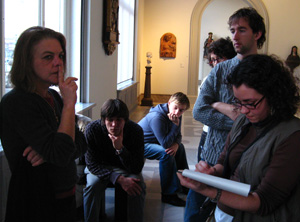
As part of the introductory week of the winter term, ‘Art, Politics, and Morality in the Florentine Renaissance’, ECLA featured two inspiring guest lectures by Professor Lynn Catterson from Columbia University.
On 8 January Professor Catterson’s lecture ‘Disrobing the Body Sculpted’ introduced the history of sculpture, in particular its various styles and their movement with transformations in the cultural and political moment. Striking features of sculptures were traced to the general cultural context in which they belonged. Students were shown how, as the Romanesque style gave way to the Renaissance, the sculpture stepped out of the buildings in which it originated. Isolated events also had an impact on sculptural development – the competition between Brunelleschi and Ghiberti in 1401 to design new bronze doors for the Cathedral’s baptistery and the hands-on experience of Donatello and Brunelleschi, brought about by the excavation of Classical structures between 1404 and 1407.
On 9 January Professor Catterson accompanied students to the Bode Museum for instruction in the more practical aspects of art history. By way of an introduction, she explained how properly to visit a museum and the importance of knowing how the collection came together and being aware of who is responsible for its state. Critical awareness thus raised, the question of authenticity proved essential while examining particular sculptures. Professor Catterson focused on the role of the material of a sculpture in judging its style, period and function. Students were taught about different kinds of relief, the use of busts and how to recognize different postures in statues. They were stimulated to practice their critical eye and actively to apply what was learned in the lectures.
Professor Lynn Catterson lectures in Renaissance Art at Columbia University. Her work focuses on Florentine sculptures. She is currently researching Michelangelo’s early career in Florence and Rome.
by Martin Lipman (’08, Netherlands)
